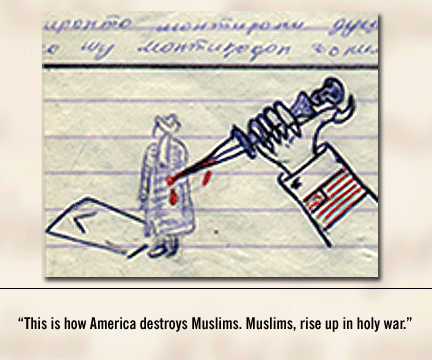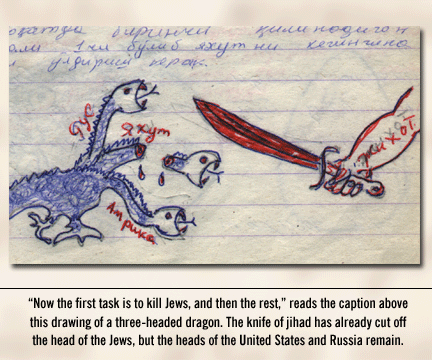CIAO DATE: 04/03
Foreign Policy
The Terrorist Notebooks
Martha Brill Olcott* and Bakhtiyar Babajanov**
Abstract
The world of a young man recruited for jihad or holy war is a frightening one. His training teaches hatred in the name of religious purification. He learns to divide people into those who embrace the true faith and properly follow its precepts and those who do not. His former colleagues and neighbors become enemies he must destroy with deadly weapons he learns to fashion out of everyday objects.
That reality describes the world of a group of Central Asians, mostly Uzbek by nationality, who went through local terrorist schools in the mid-1990s. Their course of study is laid out in 10 remarkable notebooks we acquired in 2001–2002. Covering topics such as the use of weapons, the making of poison, and the ideology of jihad, the notebooks offer a unique window into a frightening mind-set that predates the expansion of Osama bin Laden’s network in the region and still holds sway in much of Central Asia.
References in the notebooks suggest that much of this training took place in Uzbekistan’s Fergana Valley. Long a center of Islamic revival in the region, the Fergana Valley is a mix of scrub desert, low hills, and lush oases. It is the most densely populated area of Central Asia and one of the most densely populated regions in the world. Throughout Soviet rule, the valley was home to a host of underground mosques and religious “schools” that thrived even as Islamic teachings were banned or restricted. When the Soviet Union began to collapse, graduates of these schools played an important role in the revival of Islam in Central Asia, as thousands of new mosques and religious schools opened. Clerics who preached radical Islam gained new contacts and sources of financing when the mujahideen started fighting the Soviets in the Afghan war and when Saudi groups began what became a global crusade.
The late 1980s and early 1990s were difficult and confusing years for young people living in Central Asia. A seemingly invincible state had virtually disintegrated and was replaced by fragile new ones. Conditions were almost apocalyptic: The economy was in disarray, an expansive social safety net had shredded, and the powerful Red Army was in tatters, with those who served it selling off their weaponry to survive. Muslim activists who claimed that moral turpitude brought down the Soviet regime found it easy to muster arguments to bolster their cause, and they organized the Islamic Renaissance Party (IRP). Although the Uzbek government refused to register the IRP, a number of charismatic clerics who preached rejection of the secular state continued to gain supporters, especially in the Fergana Valley. And these men in turn developed armed supporters, who in the first months of Uzbekistan’s independence briefly took control of key government buildings in the city of Namangan. Fearing the outbreak of civil war, Uzbek President Islam Karimov authorized a purge of the official Islamic establishment and the arrest or disappearance of prominent unlicensed clerics and leaders of “extremist” Islamic groups.
Several prominent figures escaped the official dragnet, fleeing with followers into neighboring Tajikistan and the Tajik- and Uzbek-dominated parts of northern Afghanistan, long a host site for jihadi training camps. Thus was born the Islamic Movement of Uzbekistan (IMU), led by Soviet Army veteran Juma Namangani.
 |
 |
 |
 |
Notes
Note *:Martha Brill Olcott is a senior associate at the Carnegie Endowment for International Peace (CEIP) and author of Kazakhstan: Unfulfilled Promise (Washington: CEIP, 2002). Back
Note **:Bakhtiyar Babajanov is a senior research fellow at the Institute of Oriental Studies of the Academy of Sciences of Uzbekistan in Tashkent. Back